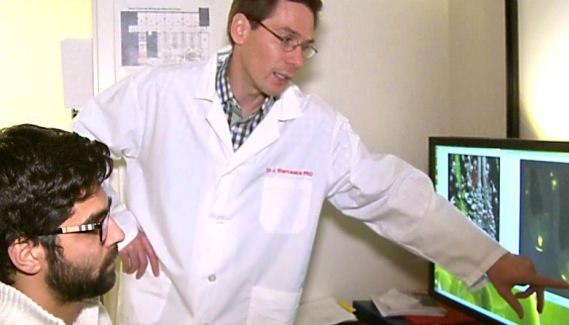Scientists from the University of Calgary say they now have the tools and base of information to move towards reversing hair loss.
Jeff Biernaskie’s research findings, published this week in the scientific journal Developmental Cell, identify the existence of a skin (dermal) stem cell in adult hair follicles that may one day be targeted to stimulate new hair growth after injury, burns, disease or aging.
“We hope that we can ultimately stimulate these cells with drugs to replenish or rejuvenate the cells that are responsible for inducing hair growth,” said Biernaskie, PhD, assistant professor in stem cell biology at the Faculty of Veterinary Medicine. Biernaskie is also the Calgary Firefighters Burn Treatment Society Chair in Skin Regeneration and Wound Healing, and a member of the Alberta Children’s Hospital Research Institute.
The cycle of degeneration and regeneration
It has long been known that a specialized group of cells at the base of a hair follicle — called the dermal papilla (DP) — is responsible for sending the signal to epidermal cells to regenerate the hair follicle and produce new hair. However, how these DP cells were maintained was a mystery.
Hair follicles undergo a constant cycle of regeneration and degeneration, and Biernaskie wanted to identify the stem cells that oversee that cycle.
“When you lose your hair, particularly in male pattern baldness, we know the reason you go bald is because of dysfunction of these cells in this group, this dermal papilla,” Biernaskie explains. “So if you look at follicles from bald skin, there’s either a huge loss in the number of cells that are there or they’ve atrophied and shrunken so they’re not functioning in the same way.”
Discovery of self-renewing cells
Biernaskie and his team of researchers hypothesized neighbouring cells located in the dermal sheath might harbour a stem cell that could function to repopulate these DP with new cells and maintain the ability to grow new hair.
By labeling cells in the dermal sheath, Biernaskie’s team discovered that a small number of dermal sheath cells could self-renew, and gave rise to hundreds of new (functionally diverse) cells in each hair follicle, including those in the DP. This discovery gives researchers a greater understanding of how hair follicles regenerate and it opens the door to creating therapies targeting stem cells to restore hair growth.
It could be a decade before such therapies are developed, but Biernaskie says having definitive evidence that a dermal stem cell exists, (something that’s been theorized in the field for a long time) is crucial to future treatments.
“We know that there is a small number of dermal stem cells In each follicle, we know where they reside in the follicle, we know how to identify them, and we now have genetic markers that we can use to pull these out of the skin,” he says. “Down the road, we might be able to look at different drugs that specifically activate these cells and not other cells. So for instance, you undergo chemotherapy and your hair is not growing back, potentially we can rejuvenate these cells in order to stimulate new hair growth.”
Goal: Identify drugs that activate key cells
Biernaskie’s research could also lead to advances in skin grafting or treating wounds. He says increasing the number of dermal stem cells within a wound might help the healing process.
“Whether it’s a burn or a chronic non-healing ulcer, if you could find a cell therapy where you could either transplant new cells into the wound or use a drug to mobilize the dermal stem cells surrounding the wound to improve healing, then I think you could really improve the quality of somebody’s life.”
Biernaskie’s research holds hope for animals as well as humans. Animals suffer skin diseases and injuries similar to people, and he says anything that improves the understanding of stem cells in healing and regeneration in people is also applicable to healing in animals.
Agencies/Canadajournal/Press Releases

 Canada Journal – News of the World Articles and videos to bring you the biggest Canadian news stories from across the country every day
Canada Journal – News of the World Articles and videos to bring you the biggest Canadian news stories from across the country every day


Congratulations to the team – I hope their work lives up to its potential!